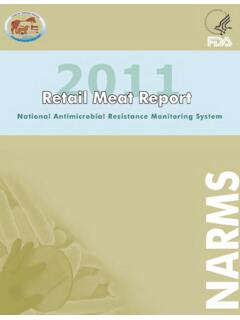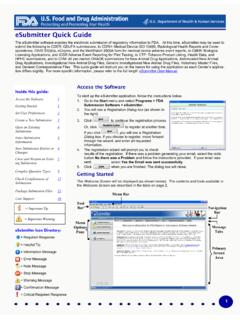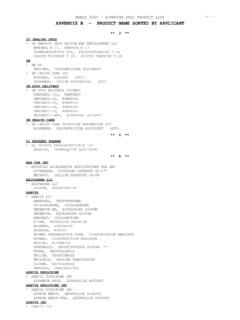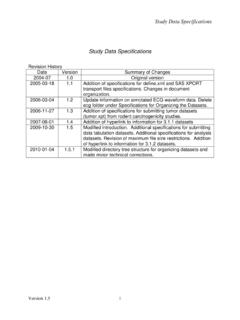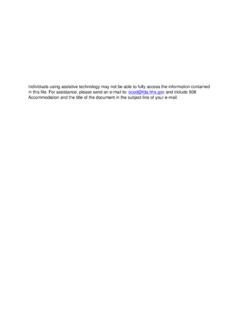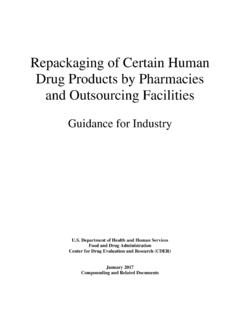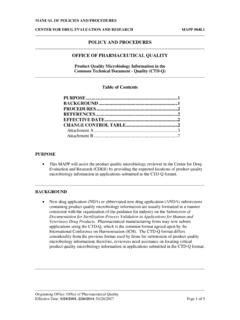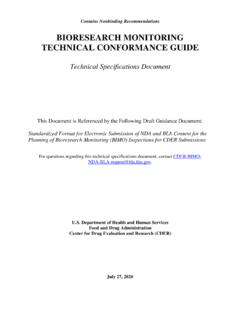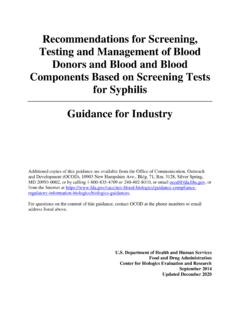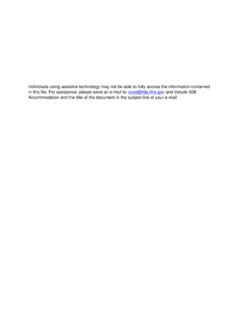Transcription of Guidance for Industry - Food and Drug Administration
1 Guidance for Industry Submission of Documentation in Applications for parametric release of Human and Veterinary drug Products Terminally Sterilized by Moist Heat Processes Department of Health and Human Services food and drug Administration Center for drug Evaluation and Research (CDER) Center for Veterinary Medicine (CVM) Center for Biologics Evaluation and Research (CBER) February 2010 CMC Guidance for Industry Submission of Documentation in Applications for parametric release of Human and Veterinary drug Products Terminally Sterilized by Moist Heat Processes Additional copies are available from: Office of Communications Division of drug Information Center for drug Evaluation and Research food and drug Administration 10903 New Hampshire Avenue Bldg. 51, rm. 2201 Silver Spring, MD 20993-0002 (Tel) 301-796-3400 and/or Communications Staff, HFV-12 Center for Veterinary Medicine food and drug Administration 7519 Standish Place, Rockville, MD 20855 (Tel) 240-276-9300 and/or Office of Communication, Outreach, and Development, HFM-40 Center for Biologics Evaluation and Research food and drug Administration 1401 Rockville Pike, Suite 200N, Rockville, MD 20852-1448 (Tel) 800-835-4709 or 301-827-1800 Department of Health and Human Services food and drug Administration Center for drug Evaluation and Research (CDER) Center for Veterinary Medicine (CVM) Center for Biologics Evaluation and Research (CBER) February 2010 CMC Contains Nonbinding Recommendations TABLE OF CONTENTS I.
2 1 II. BACKGROUND .. 2 III. CONTENT OF SUBMISSIONS for parametric release .. 3 A. Control Strategy for the Terminal Sterilization Program .. 4 B. Risk Assessment, Process Understanding, and Prior Knowledge .. 5 C. Documentation for parametric release Process .. 5 IV. FILING REQUIREMENTS .. 6 V. 7 Contains Nonbinding Recommendations Guidance for Industry1 1 2 3 4 5 Submission of Documentation in Applications for parametric release of Human and Veterinary drug Products Terminally Sterilized by Moist Heat Processes 6 7 This Guidance represents the food and drug Administration 's (FDA's) current thinking on this topic. It 8 does not create or confer any rights for or on any person and does not operate to bind FDA or the public. 9 You can use an alternative approach if the approach satisfies the requirements of the applicable statutes 10 and regulations.
3 If you want to discuss an alternative approach, contact the FDA staff responsible for 11 implementing this Guidance . If you cannot identify the appropriate FDA staff, call the appropriate 12 number listed on the title page of this Guidance . 13 14 15 16 17 18 19 20 21 22 23 24 25 26 27 28 29 30 31 32 33 34 I. INTRODUCTION This Guidance provides recommendations to applicants on information to include in support of parametric release for sterile products2 terminally sterilized by moist heat when submitting a new drug application (NDA), abbreviated new drug application (ANDA), new animal drug application (NADA), abbreviated new animal drug application (ANADA), biologics license application (BLA), or supplement or other postmarketing report. Currently, FDA requires that sterile products meet certain sterility requirements before release to the , 4 In many cases, the requirements for batch release are fulfilled by conducting a sterility test on finished units drawn from the batch.
4 parametric release is defined as a sterility assurance release program where demonstrated control of the sterilization process enables a firm to use defined critical process controls, in lieu of the sterility test, to fulfill the intent of 21 CFR (a), and (a).5 Under this strategy, market release of terminally sterilized products can be based upon meeting the defined sterilization parameters and not on performing an approved sterility test. Meeting the requirements of the parametric release process can provide greater assurance that a batch meets the sterility requirement than can be achieved with a sterility test of finished units drawn from the batch. 1 This Guidance has been prepared by the Office of Pharmaceutical Science in the Center for drug Evaluation and Research (CDER) in cooperation with CDER s Office of Compliance, the Center for Veterinary Medicine (CVM), and the Center for Biologics Evaluation and Research (CBER) at the food and drug Administration .
5 2 The term product includes final products that are regulated by CDER, CVM, and CBER. 3 See 21 CFR (d)(1)(ii)(a) or 21 CFR (b)(5)(vii)(b). 4 See 21 CFR (a) for drug products or 21 CFR for biologic products. In addition, refer to United States Pharmacopeia (USP) General Chapters: <1> (Injections), <71> (Sterility), and <1041> (Biologics). Short-lived radiopharmaceuticals, including positron emission tomography (PET) drugs, are subject to sterility testing; however, they may be released prior to completion of this test (21 CFR (a)). 5 For information on how current good manufacturing practices will be applied for products subject to parametric release that are within the scope of this Guidance , see the FDA Compliance Policy Guide (CPG) 1 Contains Nonbinding Recommendations This Guidance does not provide information on procedures, studies, or data concerning efficacy and qualification/validation of moist heat sterilization processes.
6 This Guidance also does not provide information on sterility assurance validation programs. However, you may find information relating to such topics in the Agency s Guidance for Industry on Submission of Documentation for Sterilization Process Validation in Applications for Human and Veterinary drug , 7 Current Good Manufacturing Practices (CGMP) requirements for process validation are found at 21 CFR and, for sterile products in particular, at 21 CFR (b). Adherence to CGMPs is required for all marketed products. 35 36 37 38 39 40 41 42 43 44 45 46 47 48 49 50 51 52 53 54 56 57 58 59 60 61 62 63 64 65 66 67 68 69 70 71 The principles in the Guidance may also be applicable to products sterilized by other terminal sterilization processes, such as radiation sterilization, which may be suitable for parametric release .
7 For these types of applications, we recommend the applicant discuss with the review division whether applying the Guidance would be appropriate. FDA's Guidance documents, including this Guidance , do not establish legally enforceable responsibilities. Instead, guidances describe the Agency's current thinking on a topic and should be viewed only as recommendations, unless specific regulatory or statutory requirements are cited. The use of the word should in Agency guidances means that something is suggested or recommended, but not required. II. BACKGROUND 55 Sterility testing by cultivation of finished units drawn from the batch is limited in its ability to detect contamination because of the following: (1) the small number of samples required for testing, which restricts the ability to capture those microorganisms dispersed in a large volume, and (2) the limited ability of the prescribed culture media to stimulate growth of all potential microorganisms.
8 Typically, these tests will detect only major errors in the manufacturing process that result in contamination of a large number of product units. However, data derived from in-process controls of a validated terminal sterilization process can provide more accurate information regarding product sterility because the probability of product bioburden surviving the sterilization process in any single unit of a product can be calculated to be less than one in a million. parametric release allows manufacturers to replace sterility testing of samples drawn from the finished product as a release criterion with acceptance criteria for the control of identified process parameters. These parameters, called critical parameters, are critical to a successful sterilization process and are based on an in-depth knowledge of the process, the product, the 6 This Guidance outlines the submission documentation for microbiological product quality of sterile products.
9 7 CDER Guidance documents can be found on the Internet at We update guidances periodically. To make sure you have the most recent version of a Guidance , check the CDER Guidance Web site. CVM Guidance documents can be found at , and CBER Guidance documents can be found at 2 Contains Nonbinding Recommendations effects of the sterilization process on the product itself, and any microorganisms that become associated with the product during the manufacturing process. parametric release of the batch is then based on documented evidence of the control of critical parameters, removing the need to test samples drawn from the finished product. 72 73 74 75 76 77 78 79 80 81 82 83 84 85 86 87 88 89 90 91 92 93 94 95 96 97 98 99 100 101 102 103 104 105 106 107 108 109 A sterilization load monitor,8 either in the form of a physical, chemical (ANSI 2008), or biological indicator, is included with each load to satisfy the requirement for a laboratory In addition, the sterilization load monitor is always considered a critical process parameter.
10 A successful load monitor result, the meeting of the acceptance criteria of the critical parameters, and having a well validated sterility assurance program demonstrate that there is a state of control of the manufacturing process for the product. The load monitor(s) should be placed in appropriate positions to indicate that the load was exposed to a sterilization process which was measured and recorded for conformance with defined criteria for parametric release . This position(s) is determined based on the evaluation of development and qualification data. The location and number of monitors should be described and justified in the application. Alternative procedures for demonstrating that a load or part of a load was exposed to a sterilization process should be discussed with the review division(s) prior to submitting a plan for parametric release .
